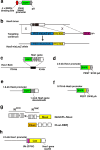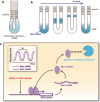Genetic visualization of notch signaling in mammalian neurogenesis
- PMID: 22971775
- PMCID: PMC3663255
- DOI: 10.1007/s00018-012-1151-x
Genetic visualization of notch signaling in mammalian neurogenesis
Abstract
Notch signaling plays crucial roles in fate determination and the differentiation of neural stem cells in embryonic and adult brains. It is now clear that the notch pathway is under more complex and dynamic regulation than previously thought. To understand the functional details of notch signaling more precisely, it is important to reveal when, where, and how notch signaling is dynamically communicated between cells, for which the visualization of notch signaling is essential. In this review, we introduce recent technical advances in the visualization of notch signaling during neural development and in the adult brain, and we discuss the physiological significance of dynamic regulation of notch signaling.
Figures




Similar articles
-
Essential roles of Notch signaling in maintenance of neural stem cells in developing and adult brains.J Neurosci. 2010 Mar 3;30(9):3489-98. doi: 10.1523/JNEUROSCI.4987-09.2010. J Neurosci. 2010. PMID: 20203209 Free PMC article.
-
Sonic hedgehog and notch signaling can cooperate to regulate neurogenic divisions of neocortical progenitors.PLoS One. 2011 Feb 17;6(2):e14680. doi: 10.1371/journal.pone.0014680. PLoS One. 2011. PMID: 21379383 Free PMC article.
-
Notch and Neurogenesis.Adv Exp Med Biol. 2018;1066:223-234. doi: 10.1007/978-3-319-89512-3_11. Adv Exp Med Biol. 2018. PMID: 30030829 Review.
-
Notch signaling in neurogenesis.Development. 2025 May 15;152(10):dev204589. doi: 10.1242/dev.204589. Epub 2025 May 27. Development. 2025. PMID: 40421980 Review.
-
MiR-34a represses Numbl in murine neural progenitor cells and antagonizes neuronal differentiation.PLoS One. 2012;7(6):e38562. doi: 10.1371/journal.pone.0038562. Epub 2012 Jun 11. PLoS One. 2012. PMID: 22701667 Free PMC article.
Cited by
-
Unlocking epigenetic codes in neurogenesis.Genes Dev. 2014 Jun 15;28(12):1253-71. doi: 10.1101/gad.241547.114. Genes Dev. 2014. PMID: 24939932 Free PMC article. Review.
-
Systems approach to the study of brain damage in the very preterm newborn.Front Syst Neurosci. 2015 Apr 14;9:58. doi: 10.3389/fnsys.2015.00058. eCollection 2015. Front Syst Neurosci. 2015. PMID: 25926780 Free PMC article.
-
Dynamic compaction of human mesenchymal stem/precursor cells into spheres self-activates caspase-dependent IL1 signaling to enhance secretion of modulators of inflammation and immunity (PGE2, TSG6, and STC1).Stem Cells. 2013 Nov;31(11):2443-56. doi: 10.1002/stem.1499. Stem Cells. 2013. PMID: 23922312 Free PMC article.
-
Breast carcinoma-amplified sequence 2 regulates adult neurogenesis via β-catenin.Stem Cell Res Ther. 2022 Apr 11;13(1):160. doi: 10.1186/s13287-022-02837-9. Stem Cell Res Ther. 2022. PMID: 35410459 Free PMC article.
-
Astragalus Flavone Induces Proliferation and Differentiation of Neural Stem Cells in a Cerebral Infarction Model.Med Sci Monit. 2022 Mar 7;28:e933830. doi: 10.12659/MSM.933830. Med Sci Monit. 2022. PMID: 35250022 Free PMC article.
References
Publication types
MeSH terms
Substances
LinkOut - more resources
Full Text Sources
Other Literature Sources

